 advertisements advertisements
|

|
Mary Cleave, astronaut who led NASA's science division, dies at 76
November 29, 2023 — Former astronaut Mary Cleave, who launched twice on the space shuttle before becoming the first woman to head NASA's science division, has died at the age of 76.
Cleave's death on Monday (Nov. 27) was confirmed by NASA's outgoing associate administrator Bob Cabana, who was also a shuttle astronaut.
"I'm sad we've lost trail blazer Dr. Mary Cleave," said Cabana in a statement. "Mary was a force of nature with a passion for science, exploration and caring for our home planet. She will be missed."
A scientist with training in civil and environmental engineering, as well as biological sciences and microbial ecology, Cleave was a member of NASA's ninth group of astronauts selected in 1980. She became the 10th woman to fly into space on the first of her two missions, logging a total of 10 days and 22 hours in Earth orbit.
Cleave's first flight was a mission specialist on the second launch of the space shuttle Atlantis on Nov. 27, 1985. As a member of the STS-61B crew, she helped film the deployment of three communications satellites and took control of the orbiter's robotic arm to assist her spacewalking crewmates test techniques for constructing structures in orbit.
"They couldn't fit me in a spacesuit because I was too small," said Cleave in a 2002 NASA oral history interview. "So I was a flight engineer on that flight, and I flew the arm. That was, for me, a real disappointment when I found out I couldn't go [out on an] EVA [extravehicular activity], but I was happy with how it came out."
STS-61B was the first mission to use the robotic arm to move astronauts around as if they were on a cherry picker, but in space.
"It really worked," said Cleave. "I had to train really carefully because there are failure modes in the arm where it can start just moving ... really rapidly, so I had to be very careful to know exactly where it was at all times and where it should be going, so if I had to throw on the brakes, I didn't squash these guys and get them wedged in between the arm and the structure."
"That was the hardest part of that whole thing, because there were definitely safety aspects of it that I had to be really, really careful of, because I did not want to go back to either Jerry [Ross] or Woody [Spring's] wife and say, "Sorry, I squashed your hubby." That was not something I wanted to do," she said with a laugh.
Cleave also conducted experiments for the 3M company.
"I did five different crystal experiments for them, of which four I had to sign a proprietary agreement on," said Cleave. "But the fifth one was an organic compound that conducted electricity. So even back then, they were thinking about making organic compounds that you could use as a chip, at a molecular level. So it was interesting work."
As the mission's flight engineer, Cleave was seated for both the launch and landing on the flight deck, behind and between the commander (Brewster Shaw) and pilot (Bryan O'Connor). Her tasks included deploying the airspeed probes, keeping track of the commands called up from Mission Control and calling out flight milestones.
"I had to write something on my kneeboard, and it was when we were pulling about a quarter of a G and my arm felt like it was about ten pounds and I went, 'Oh god, I'm not going to make it. I'm going to be flat here.' But then I didn't really notice it after that till I tried to get out of the chair," Cleave said, referring to her readjustment to the pull of gravity on her return to Earth.
Atlantis touched down at Edwards Air Force Base in California on Dec. 3, 1985.
"We could hear the wheels on the runway at Edwards before we could feel anything on our rear ends. It was so smooth," she said. "It was better than any airline landing."
Cleave returned to space four years later, again aboard Atlantis, on May 4, 1989. As a mission specialist on the STS-30 crew, she was the first woman to fly since the Challenger tragedy in January 1986.
"People tried to make a point of it, and I just let everybody know that I didn't think that anybody should be making a special point out of this," said Cleave. "There were two women that were on the Challenger when it went. Judy [Resnik] happened to be a very good friend of mine. So it was just a normal part of the thing, and I just didn't think it was good to make anything special out of it, because at that point we really were part of the corps."
Cleave and her crewmates deployed the Venus-bound probe, Magellan.
"It was the first time we deployed a spacecraft that was going to another planet from the shuttle. So it was a lot of fun," she said. "Working [with] the guys from JPL [the Jet Propulsion Laboratory in Pasadena, California], it was great. That was, to me, one of the slots you could give a mission specialist that was a meaty assignment, so I was really happy."
Cleave also worked with fellow mission specialist Mark Lee to remove and replace a failed general-purpose computer and used a laptop computer to run and monitor a fluids experiment apparatus.
"We were the first guys to try to ... collect information on a floppy [disk]," Cleave said. "[So] that was a much more interactive thing."
STS-30 landed on May 8, 1989 at Edwards. The Magellan probe entered orbit around Venus 15 months later, where it mapped the planet until October 1994.
"Magellan did great work, and got me interested in unmanned spacecraft," Cleave said.
Mary Louise Cleave was born on Feb. 5, 1947 in Southampton, New York. She received a bachelor of science degree in biological sciences from Colorado State University in 1969 and master of science in microbial ecology and a doctorate in civil and environmental engineering from Utah State University in 1975 and 1979, respectively.
Cleave was working at the Utah Water Research Laboratory at Utah State University when she learned NASA was recruiting a new class of astronauts. She filled out the application but was not selected. Then, two years later, a postcard arrived.
"[It] said, 'Are you still interested?' I sent it back saying yes, refilled out my whole application to make sure they got the whole thing, sent it in, and the second time around, I got the call for the interview," said Cleave.
Before joining the STS-61B crew, Cleave filled technical assignments, including verifying flight software in the Shuttle Avionics Integration Laboratory SAIL), designing crew equipment and developing a malfunctions procedures book. She also served as capcom (or spacecraft communicator) in Mission Control during five space shuttle missions.
"I know I was there [in Mission Control] for STS-7 because I was on when Sally [Ride was on] — we were the first female-female connection," said Cleave.
Cleave was in the Astronaut Office at Johnson Space Center watching the launch when the STS-51L crew was lost aboard space shuttle Challenger in 1986. She served as a family escort and then was put in charge of the analysis of the crew compartment after it was recovered.
After returning from STS-30, Cleave joined the engineering division at Johnson, working on life support systems. She was offered another mission, but decided to pursue her interest in Earth science instead.
"I had a hell of a time making the decision," she said. "The amount of pressure that goes in to people when you decide you don't want to do what most people consider to be the best job on the planet was really pretty tough. This is a very tough transition, because basically you're going from a job where you're saying, 'This job is so important, I'm willing to risk my life for it.' Then you have to go through the mental trip of going, 'Okay, this job is that important, but now I'm going to do something else.' For me, it was a really hard transition, but it worked out great. I have no complaints at all."
Cleave transferred to NASA's Goddard Space Flight Center in Greenbelt, Maryland in May 1991. There, she worked in the Laboratory for Hydrospheric Processes as the project manager for SeaWiFS (Sea-viewing, Wide-Field-of-view-Sensor), an ocean color sensor which monitored vegetation globally.
In March 2000, Cleave was named the deputy associate administrator for advanced planning in the Office of Earth Science at NASA's Headquarters in Washington, D.C. From August 2005 to February 2007, she was the associate administrator for NASA's science mission directorate where she guided an array of research and scientific exploration programs for Earth, space weather, the solar system and the universe. She also oversaw an assortment of grant-based research programs and a diverse constellation of spacecraft, from small, principal investigator-led missions to large flagship missions.
Cleave retired from NASA in February 2007.
For her service to the U.S. space program, Cleave was awarded the NASA Space Flight Medal, the NASA Exceptional Service Medal, the NASA Exceptional Achievement Medal and was named NASA Engineer of the Year, among other honors. She was inducted into the Maryland Women's Hall of Fame in 2002 and the Long Island Air and Space Hall of Fame in 2010.
In 1995, Cleave was featured on a postage stamp issued in Azerbaijan as part of a set commemorating the 25th anniversary of the first moon landing.
Cleave is survived by two sisters, Gertrude "Trudy" Carter and Barbara "Bobbie" Cleave Bosworth. |
|
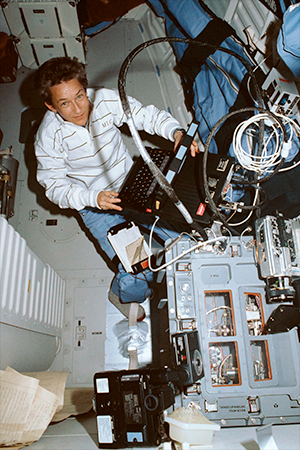
Astronaut Mary Cleave is seen on the mid-deck of the space shuttle Atlantis using a laptop computer to run a fluid experiment apparatus during the STS-30 mission in May 1989. (NASA)
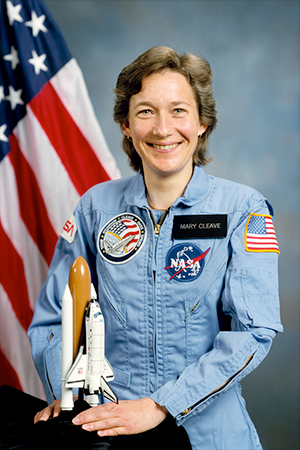
NASA portrait of STS-61B mission specialist Mary Cleave. (NASA)

Mary Cleave floating in midair during her STS-61B mission training on board the KC-135 reduced gravity aircraft in 1985. (NASA)
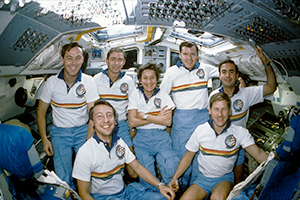
Mary Cleave poses on the aft flight deck of space shuttle Atlantis with her STS-61B crewmates: Jerry Ross, Brewster Shaw, Bryan O'Connor, Rodolfo Neri, Woody Spring and Charlie Walker. (NASA)
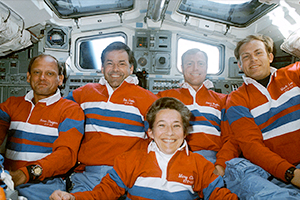
Mary Cleave poses on the aft flight deck of space shuttle Atlantis with her STS-30 crewmates: Norm Thagard, Ronald Grabe, David Walker and Mark Lee. (NASA)
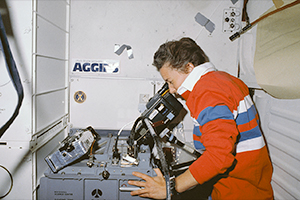
STS-30 mission specialist Mary Cleave operates an 8mm video camcorder with the Fluids Experiment Apparatus 2 unit located in an aft middeck locker on board space shuttle Atlantis. (NASA)

Mary Cleave speaks during an astronaut panel discussion at the 70th International Astronautical Congress in 2019, at the Walter E. Washington Convention Center in D.C. (NASA/Aubrey Gemignani) |
|

© collectSPACE. All rights reserved.
|
|

|

|
